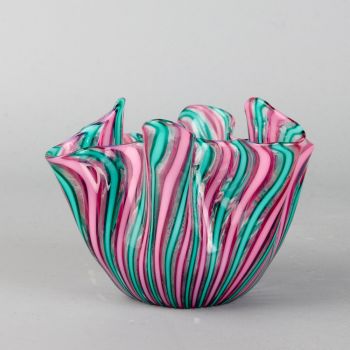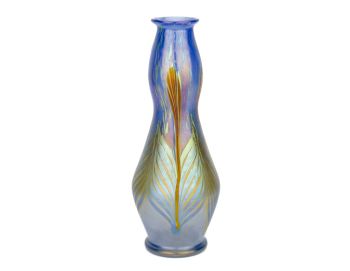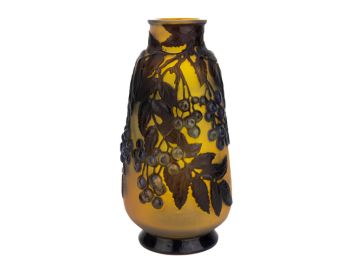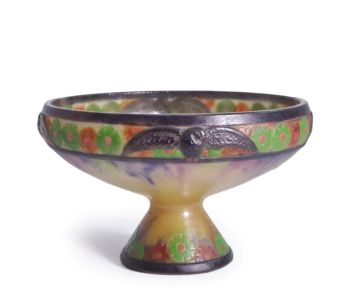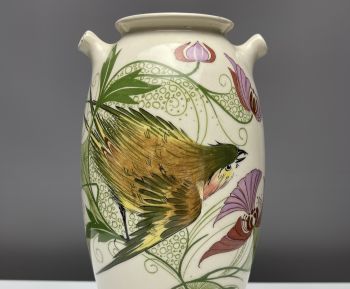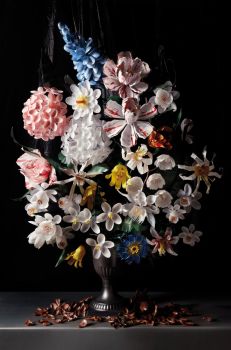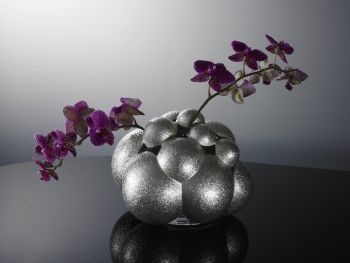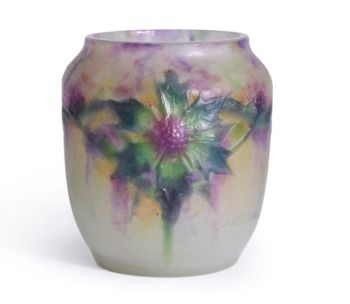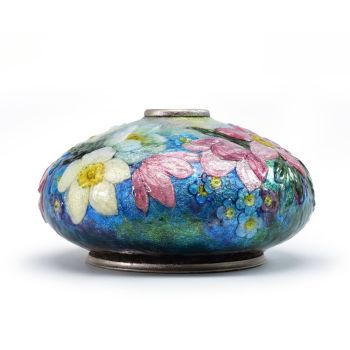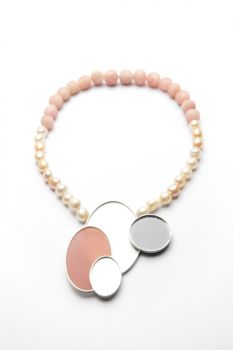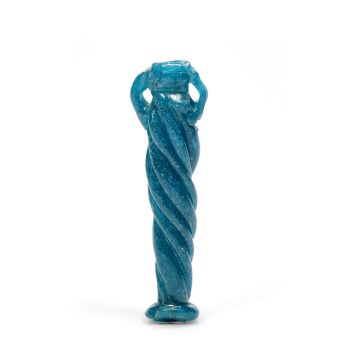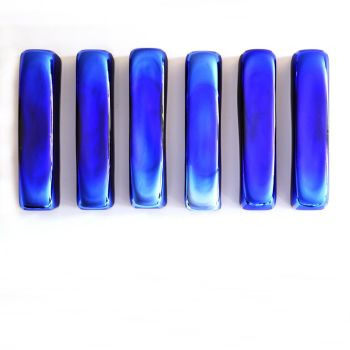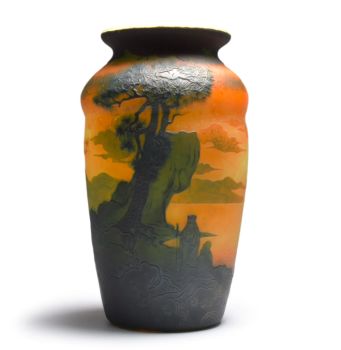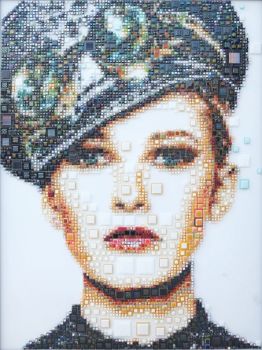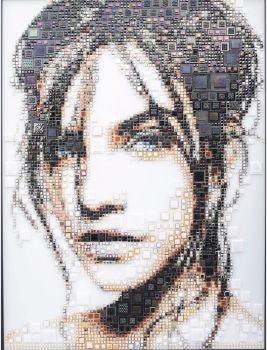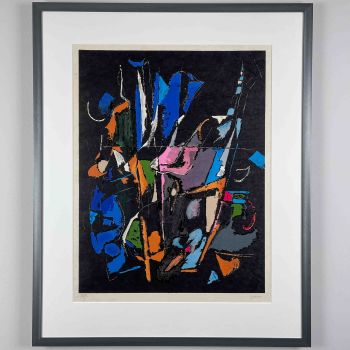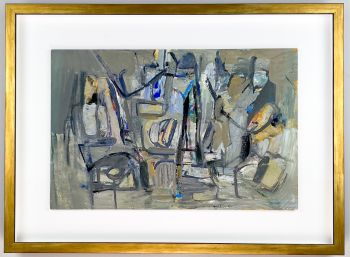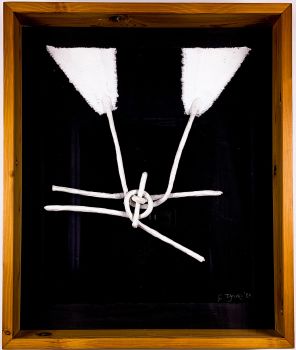Complete set of glass art object “Prisma”, model KF 215 in largest size – Nuutajärvi-Notsjö, Finland 1958 - 1965
Kaj Franck
Bicchiere
21 ⨯ 14 ⨯ 9 cm
ConditionVery good
€ 4.750
Van Kerkhoff Art
- A proposito di opere d'arteA complete set of all the colour-variants of Art-object “Prisma”, model KF 215. Designed by Kaj Franck in 1954 and executed by the Nuutajärvi-Notsjö glassworks, Finland between 1958 and 1968.
These rare freeblown, encased, cut and polished glass vases were made between 1958 and 1968 in four different sizes ranges and three colour-variants. This therefore is a set of all variants in the largest size range.
The purple example is a rare very early production. It is noticebly more slender than it’s countreparts. The method of making these elegant objects was very difficult to master and although Franck designed the Prisma in 1954 it took the craftsmen of Nuutajarvi several years to blow the object as intended by Kaj Franck.
They are all marked underneath the base in diamondpen. The purple end yellow Prisma’s are signed Kaj Franck Nuutajärvi-Notsjö, followed by the date. The brown example is marked with the factory name only. This indicates that the brown Prisma was made around 1965 as In accordance with Kaj Franck’s ideas regarding the role of the artist in the creative process, his designs were – from mid-1960’s to the late 1960’s – signed with the factory name only
About Kaj Franck
Kaj Franck (Vyborg, Finland 1911 – Santorini, Greece 1989), a pioneering Finnish designer and a prominent figure in the Finnish art world from 1940 to 1980, left an indelible mark on the design landscape. Today, his name is synonymous with excellence and innovation, as exemplified by the prestigious “The Kaj Franck Design Prize,” which is annually awarded by the esteemed Finnish Design Forum.
Born in 1911 on the Finnish-Russian border into a family with a rich architectural heritage, Franck had design in his blood. His grandfather held a prominent position as the director of the renowned Arabia Ceramics factory, underscoring the influence and inspiration that surrounded him from an early age.
Franck pursued his passion for design by studying at the furniture department of Taideteollinen korkeakoulu, known today as the Aalto University School of Arts, Design, and Architecture, in Helsinki. Equipped with a solid foundation in design principles, he embarked on a career as a freelance designer before joining Arabia in 1945. It was during his time at Arabia that Franck’s talent truly flourished, and in 1950, he assumed the role of the company’s Artistic Director.
While his contributions to Arabia were significant, Franck’s creative vision extended beyond ceramics. He also designed glass objects for Iittala between 1946 and 1950, and later for Nuutajärvi-Notsjö glassworks from 1950 to 1976. His designs, particularly in everyday tableware and glassware, propelled him to the forefront of the design world. Notably, his iconic Kilta tableware and Kartio glassware are celebrated as revolutionary and enduring symbols of classic Finnish design.
Franck’s design philosophy embodied a profound commitment to principles of moderation, ecology, and equality. Often referred to as “the conscience of Finnish design,” he advocated for minimalism and the conscious reduction of everyday objects, emphasizing the importance of sustainability and product life cycles. Franck’s designs were a testament to his belief that beauty and functionality could coexist harmoniously, enhancing the lives of individuals while respecting the environment.
Recognized for his exceptional contributions, Franck’s works grace the collections of esteemed museums worldwide. Noteworthy institutions such as the Design Museum Helsinki, the Museum of Modern Art in New York, the Stedelijk Museum Amsterdam, and The British Museum in London all proudly display his creations. Throughout his illustrious career, Franck received numerous accolades, including the prestigious Lunning Prize in 1955, as well as “Grand Prix” and multiple “Gold Medals” at the renowned Triennale di Milano.
Kaj Franck’s enduring legacy rests not only on his remarkable designs but also on his unwavering commitment to advancing the field of design. His vision, which emphasized sustainability, simplicity, and social consciousness, continues to inspire designers and enthusiasts alike, ensuring that his influence will be felt for generations to come.
Marked
Signed in diamondpen underneath the base:
Kaj Franck Nuutajärvi-Notsjö '58 (Purple)
Kaj Franck Nuutajärvi-Notsjö '61 (Yellow)
Nuutajärvi-Notsjö (Brown)
Execution
Nuutajärvi-Notsjö glassworks, Finland 1958-1968
Condition
These Prisma's are in good vintage condition. Some light scratches and wear consistent with age and use. Additionally the Purple one has a knurled scratch on the front middle corner. The Brown Prisma has a small restoration on the base. No chips or cracks.
Literature
Marianne Aav (ed.), Kaj Franck, Universal Forms, p.222, p.323
Dimensions
Height 20,1, 20,9 & 21,5 cm
Width 14, 15,3 & 14,8 cm
Depth 7,1, 8,8 & 9,3 cm - A proposito di opere artista
Il designer finlandese di ceramica e vetro Kaj Franck (1911-1989) ha realizzato una potente verità nella sua illustre carriera: semplice è bello. Nonostante il mondo si muova a un ritmo sempre più veloce, da un decennio all'altro, quella semplice verità rimane. L'ispirazione ei principi di Franck hanno dato inizio a una tradizione nel design finlandese, che è ancora viva e forte oggi. Le sue opere più note sono Iittala Teema e la serie Kartio, e la sua eredità fa parte di ogni casa finlandese.
"Voglio fare uso di oggetti che sono così ovvi da non essere evidenti", Kaj Franck ha definito il proprio lavoro. I suoi progetti soddisfacevano i bisogni umani di base mentre servivano loro strumenti con proprietà di oggetti di uso quotidiano. Franck era anche interessato a basso- costò la produzione di massa e rifiutò il materialismo, la cultura dell'usa e getta e l'ostentazione. Il mondo di Franck consisteva nelle forme matematiche di base e nelle forme semplici, decorate solo con colori forti.
Il punto di partenza del lavoro di Franck era la praticità unita alla bellezza. Anche se oggi sembra ovvio, ai suoi tempi i suoi pensieri erano radicali. Franck ha separato gli stili e le tendenze della moda dalla tradizione e gli ha dato un significato completamente nuovo. Nel periodo 1952-53, Franck ha dimostrato che le stoviglie non devono essere eccessivamente complesse con l'uscita della serie Kilta come affermazione forte: era un'idea nuova che ognuno fosse in grado di apparecchiare la tavola secondo le proprie esigenze .
Franck ha iniziato i suoi progetti concentrandosi sull'idea o sul concetto sottostante, non sulla forma. Questa enfasi sull'aspetto ideativo del design è stata trasferita anche al suo lavoro come insegnante e successivamente come direttore artistico presso l'Università di Arte e Design di Helsinki. Franck è stato anche uno dei primi sostenitori del riciclaggio ed è stato spesso definito la "coscienza del design finlandese". Franck ha vinto numerosi premi nella sua illustre carriera ed è diventato famoso a livello internazionale. Oggi, il Kaj Franck Award è il riconoscimento di design più prestigioso della Finlandia .
Sei interessato ad acquistare questa opera d'arte?
Artwork details
Related artworks
- 1 - 4 / 10
- 1 - 4 / 24
Daum Nancy
Daum Nancy – Tall rare early Art Nouveau vase executed in “Cygnes (swans)” motif – Circa 18921890 - 1899
Prezzo su richiestaAntiques Emporium
Artista Sconosciuto
François-Théodore Legras – Tall “Fleurs de Pommier” apple blossoms vase1900 - 1909
Prezzo su richiestaAntiques Emporium
Johann Loetz (Lötz) Witwe Klostermühle
Johann Loetz Witwe – Ausfuehrung 146 Titania vase – 19121910 - 1919
Prezzo su richiestaAntiques Emporium
Demetre Chiparus
Demetre H. Chiparus – Bronze Art Deco statue “Rapture” – Édition Etling, Paris1920 - 1929
Prezzo su richiestaAntiques Emporium
Gabriel Argy-Rousseau
Gabriël Argy-Rousseau – Crabes et Algues vase – 19201920 - 1929
Prezzo su richiestaAntiques Emporium
1 - 4 / 24Johann Loetz (Lötz) Witwe Klostermühle
Johann Loetz Witwe – Phänomen Genre vaas in blauw opaal – 19021902 - 1903
Prezzo su richiestaAntiques Emporium
Paulus Franciscus Kromjong
Fiori davanti ad Arearea Aka (gioia) di Gauguin'20th century
Prezzo su richiestaZebregs & Röell - Fine Art - Antiques
Artista Sconosciuto
François-Théodore Legras – Tall “Fleurs de Pommier” apple blossoms vase1900 - 1909
Prezzo su richiestaAntiques Emporium
1 - 4 / 24Frères Daum
Daum Nancy – “Paysage Soleil Couchant” vase with two applied handles1900 - 1910
Prezzo su richiestaAntiques Emporium
Gyrinus
Verre gravé pointillé avec putti1764 - 1766
Prezzo su richiestaPeter Korf de Gidts - Antiquairs
1 - 4 / 24Shinkichi Tajiri
“Koan” 1988 – papier-mâché / cotton on paper, original frame1988
Prezzo su richiestaVan Kerkhoff Art
1 - 4 / 12

















































